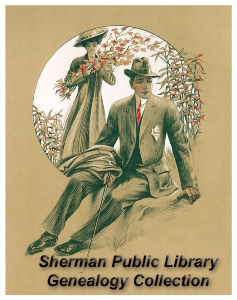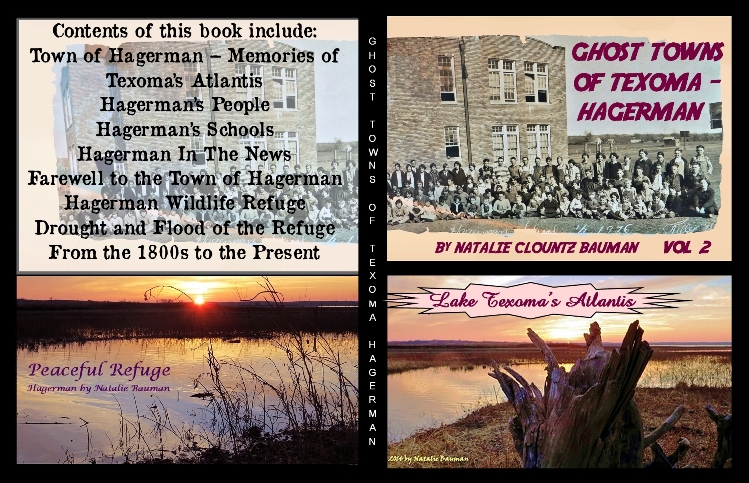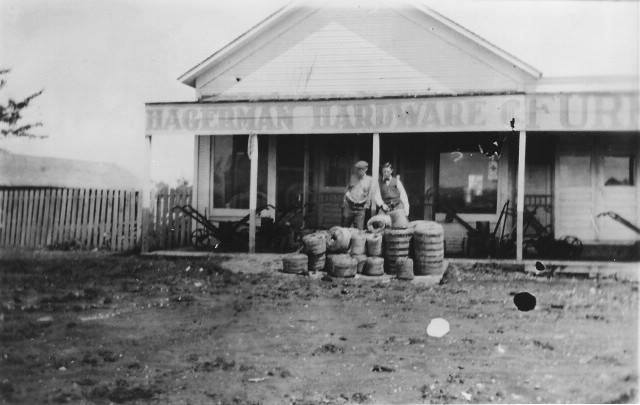
1880 - 1943

In
1889 the Smith brothers, J. P., W. N. and Maurice, originally from
Fordyce, Arkansas, bought the O. H. Willis Survey east of Big Mineral Creek
in
Grayson County.
When the section was divided among the brothers in
1904, J. P. Smith had 10 acres in the North East corner surveyed. The
streets were designated and named. The Missouri, Kansas & Texas
Railroad switch already at the site had been named Hagerman for an
official of the railroad.
T. M. Smith, another brother, had joined
the Smiths on the farm. He, with his wife, Ida and daughter, Norah,
occupied the first residence on the townsite. W.N. Smith, his wife,
Lucy, and son Elbert, moved into the second residence. They reared
their family, including Elbert, Bruce, Mary, Robert and Edwin in the
area. All made valuable contributions to the community.
Several
families were established in the vicinity. In 1888, Judge Seth Daniel
Steedman, former Judge of Grayson County, moved to a farm near Dever
Switch about a mile west of the Hagerman Switch. The community was
originally called "Steedman " in honor of Judge Steedman. The
Steedman
postoffice was established in 1880 in the Steedman home with Mrs.
Steedman as
post-mistress. The postoffice was later moved to the Henderson store,
also near Dever Switch. This postoffice was discontinued.
The U.S. postoffice was established at Hagerman with A.B. McClendon as
the first postmaster. R. L. Sweeney was the last postmaster. He was
transferred from the discontinued postoffice to Perrin Air Force Base
postoffice where he is still serving.
The
Hagerman Baptist Church, Hagerman Cemetery and the Hagerman National
Wildlife Refuge are the
only remaining users of the name Hagerman.
"In 1904 James
Patillo (J.P.) Smith platted streets here in a ten acre wheat field and
established the town of Hagerman, located between Denison and
Whitesboro on the Missouri, Texas & Kansas railroad line and
named for railroad attorney James P.
Hagerman. He
was soon joined by the rest of the family, brothers Tom and Richard,
and sisters, Sally Will and Susan Rebecca. J.P. married Sallie
Hunt; their direct descendants were Mary Webb Morrison, Hunt Smith, and
Willie Sue Grace. Right
before Christmas in 1926 three stores were destroyed by fire on the
east side of the street; the flames set off fireworks. The three
merchants left town to operate businesses in other places. In January
1927 the bank closed its doors. People began to move away causing the
school to drop from 4 teachers to 3 teachers. Thus began the decline
of the quiet, little village. The small light plant which provided
electricity wore out and was not repaired or replaced. People said
"the dam will probably be built, so why invest money in a dying
project?" So the residents dug out their old oil lamps and put them to
use once again. In 1928 the lumber yard moved to Whitesboro and in
1932 the gin moved to Collinsville. A year later an unusual accident
happened at the cotton gin (Sherman Democrat, July 4, 1976)
The
town consisted of 250
residents, a cotton gin, school, church, post office, railroad depot,
and several businesses by 1910. The village's first postmaster
was A.B. McClendon. "In 1927 R.L. Sweeney moved the post office
to his store which was formerly the bank building; he served as
postmaster until 1943 when the post office was disbanded."
("Hagerman, Now Only A Memory." Sherman Democrat, July 4, 1976)
"On
the second floor of the Bean Brothers store was the Woodman Hall where
the community gathered for box suppers, beauty contests, dances and
programs. Johnnie Shires was the only Justice of the Peace the
town ever had; he performed weddings on one side of the street while
Brother Scott, a minister, performed the wedding ceremonies on the
other side of the street." ("Hagerman, Now Only A Memory." Sherman Democrat, July 4, 1976)
The
town prospered and grew to contain
three churches and a three teacher school. However in the 1920s
residents and businesses began to abandon the area when it became kn
own
that the creation of Lake Texoma would completely inundate the town.
Lake Texoma was created in 1943." In the 1930s and 1940s the
population was reported as 150. Thought most of the townsite was
submerged under Lake Texoma in 1944, Hagerman is marked on the 1970
county highway map by a church, and several miles away, a cemetery.
"Hagerman
merchants joined together to sponsor a trades day which included a
rodeo with local boys, John Bean, Clifford McClendon and Ralph Dunning
among those vying for the prizes.

Hagerman History

Ghost Towns of Texoma, vol 2 ~ Hagerman
by Natalie Bauman
available at Amazon.com

Four
Ghost Towns Under Lake Texoma
Friends of Hagerman NWR
Hagerman
Hagerman
Community
Hagerman National Wildlife Refuge
Secrets of the Lake
NOTICE
All Hagerman photographs are the personal property of Natalie Bauman. They are not for commercial, private or public use.
For information regarding her photographs and photography, please contact her at nataliedbauman@aol.com.
Towns
Susan Hawkins
© 2024
If
you find any of Grayson
CountyTXGenWeb links inoperable, please
send me a message.
|





